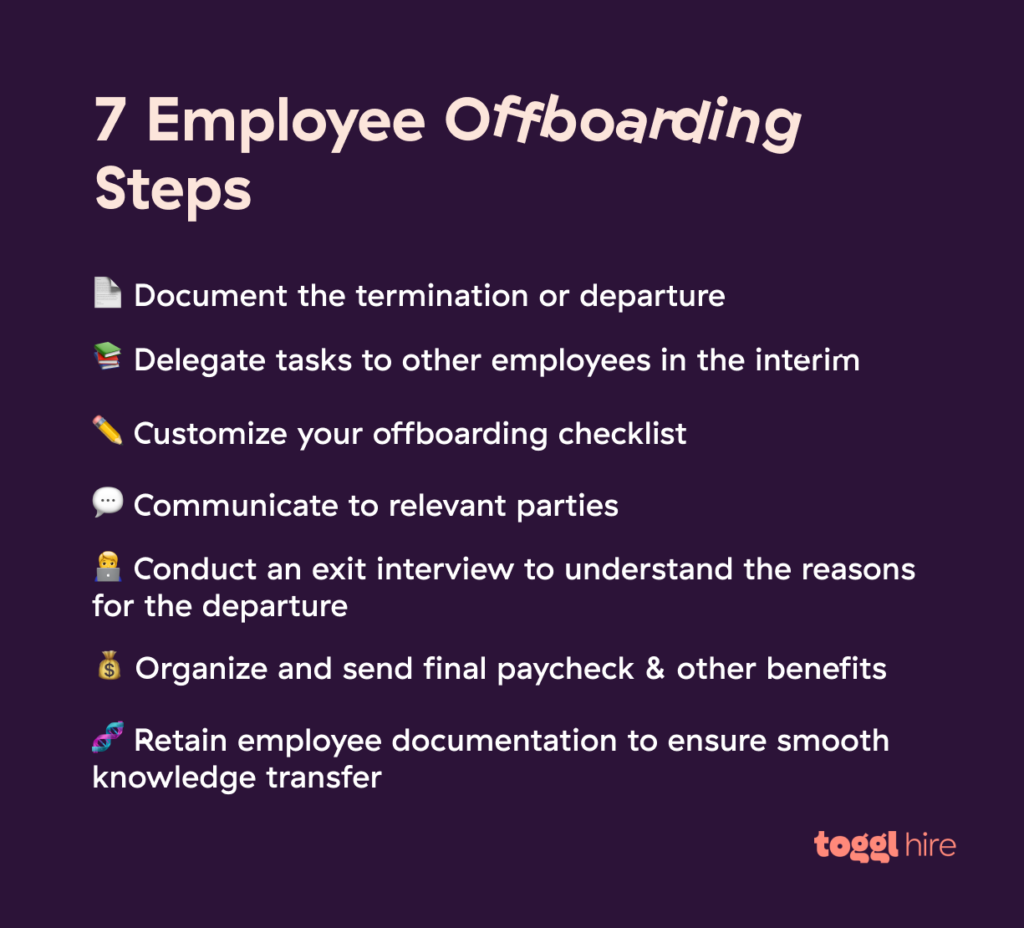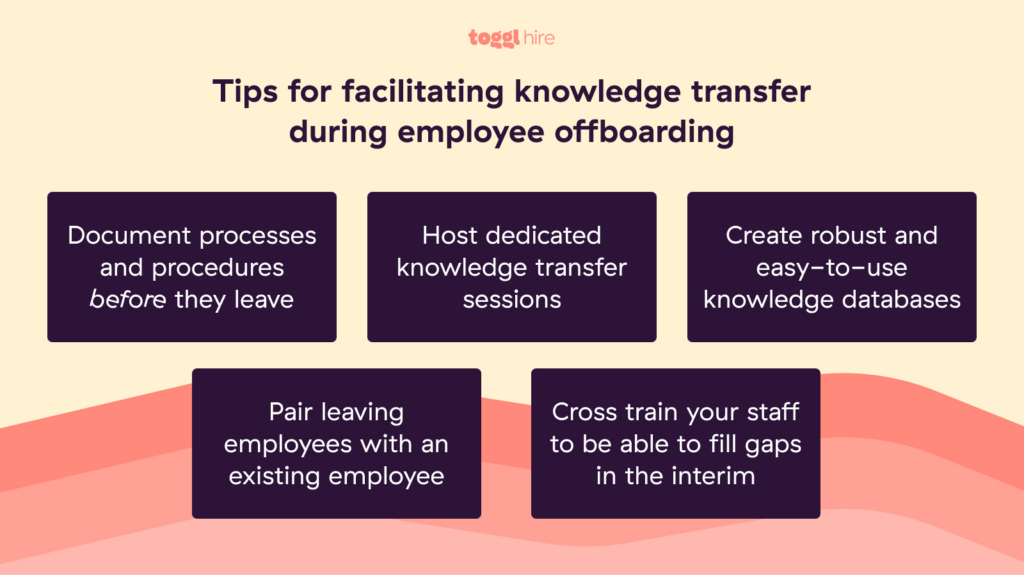71% of companies lack a formal employee offboarding process, which honestly makes a lot of sense given that, in today’s war for talent, most companies are too focused on attracting new employees to properly consider what happens when their existing employees leave.
But, like many other shortcuts in hiring, that could be a costly mistake. Parting ways positively can help leave a lasting good impression, collect precious feedback, or even turn employees into customers, just to name a few benefits of having not only an offboarding process but an offboarding checklist.
If you’ve been too busy attracting candidates to even consider something like this, then you’re in luck. We’re about to show you how to handle employee offboarding properly. We’ll start with an offboarding checklist to add to your HR arsenal and end with our top tips on the best way to say ciao.
TL;DR — Key Takeaways
Employee offboarding is the process of managing an employee who leaves your company due to resignation, retirement, termination, or a similar reason.
Following an offboarding process is important for many reasons: it can improve your employer brand, facilitate knowledge transfer, create a supportive work culture, turn past employees into future customers, and be used to collect valuable feedback from departing employees.
Our employee offboarding checklist includes nine steps: exit interview, reclaiming company assets, revoking access, updating internal systems, knowledge transfer, farewells and giving recognition, creating a feedback loop, and the post-offboarding engagement.
For the best employee offboarding process, communicate openly, maintain professionalism and respect, and use technology and tools to save time.
What is employee offboarding?
Employee offboarding is the process of managing an employee who leaves your company, whether for resignation, retirement, termination, or other similar reasons.
While most companies customize their offboarding process to suit their business needs and size, it should cover all the relevant tasks and processes for ending the relationship to the benefit of both the former employee and your business.
When an employee leaves, offboarding is the final step of the employee lifecycle. It lets both parties learn something from the former relationship. Improving your offboarding process can help you crush your recruitment goals and become a better employer.

Why is an offboarding process so important?
Have you ever heard of the expression “burning bridges?” Sure you have, and it’s incredibly important when managing a person who’s about to become a former employee.
When someone leaves, neither side should burn the bridge behind them. An effective offboarding process can help turn an exiting employee into a future brand ambassador and allow the employer to build a better company culture for future employees.
Former employees are brand ambassadors
Your existing employees talk about you as an employer (even if you don’t think they do!), but they’ll also continue to do that once they leave. After their final paycheck, they’ll share their thoughts with their family, friends, peers, other potential applicants on social media, etc.
A well-structured offboarding process can do wonders for your employer brand and ensure the employee says good things about your company. This can encourage new talent to join your team and pave the way for new business opportunities and partnerships, among other things.
Facilitates knowledge transfer
The leaving team member has a wealth of knowledge about their position. When that employee leaves, that knowledge is lost, and it may take months for the remaining team members to pick up the scraps and mentor the new hires you make.
When the leaving employee has a solid offboarding process, they have enough time to share that knowledge with the remaining team members. This knowledge transfer makes their lives easier and ensures easier onboarding for new employees.
Some ways you can facilitate knowledge transfer during offboarding include:
Documenting processes and procedures
Knowledge transfer sessions
Creating knowledge repositories
Pairing up the leaving employee with a teammate to work on tasks together
Doing cross-training

Supports a positive workplace culture
The way a company offboards employees also says a lot to the remaining team members about how the company sees its employees. Quality employee offboarding reinforces the idea that you are committed to every single team member and that you have a strong company culture.
The employees who stay may feel sad about the person leaving, but they’ll also get a boost in morale and engagement, resulting in better employee retention. You may even see a surge in productivity, too.
A departing employee could be a customer
Former employees understand the pros and cons of a company’s offer better than any outsider. That’s why, in the future, they’re likely to become customers since they know the competitive landscape and what makes you the best offer around.
And even if those former employees do not become new paying customers, they can refer others to you and keep spreading the good word long after their departure.
Yields constructive feedback
Departing employees have little to lose since they already have one foot through the door. This means that the exit interview when offboarding employees is the ideal opportunity to gather constructive, honest feedback and prevent future employee attrition.
This is your chance to learn more about the work environment, any issues with direct and indirect managers, feedback on company policies, people relations, and just about anything that interests you in an effort to improve internal operations and culture.
Employee offboarding checklist
By now, you know that employee offboarding has many benefits. But if you’ve never done it before, you won’t know where to start, which is why we’ve prepared an employee offboarding checklist template that you can follow and copy.
It includes nine critical steps that you should start immediately after someone starts their notice period.
Following this offboarding checklist ensures you successfully recover company assets, preserve the knowledge of the leaving employee, and honor your existing employees.
1. Conduct an exit interview
Employee exit interviews are the core of a positive offboarding experience. Through the exit interview, the exiting employee has a unique chance to gather invaluable, honest feedback that can help your organization grow and fix any underlying issues you may have.
Here are some insights from Camille, an HR Counselor and content creator we love. 👇
2. Reclaim company assets
When an employee leaves, they usually need to return any company property, such as laptops, mobile phones, ID badges, and files. While often overlooked, reclaiming company property is especially important when working with remote employees.
You should already have a detailed checklist for each employee covering all the company-owned equipment in their possession. This is usually stored in your HR software to keep tabs on who has what (and where!).
Refering to this checklist or database makes it quick and easy to request the returns and check that the serial numbers match. It may not seem like a big deal, but losing one phone or tablet at a time could make a huge dent in your budget over the years.
3. Access revocation
As the employee’s end date approaches, your IT team will need to revoke their access to key platforms and resources. Think emails, Slack, file-sharing services, client-facing apps, and anything else that they can log into.
That leaves us with a critical question: when should you revoke systems access?
Ideally, you should have a company policy on when departing workers lose system access. But here are some ideas to inspire you.
Revoking access immediately: This is done in cases where there could be security issues, when the departing employee has access to sensitive data, or where the departure is not on good terms or based on misconduct.
Revoking access after a transition period: If an employee is working all the way through their notice period, you can give them partial or full account access until their final day. However, depending on the nature of the departure, you might want to monitor what they do with their accounts closely.
Giving role-based access control: Until the employee’s end date, you can give them access only to platforms that are crucial for performing their work. For example, you could give someone in customer support access to your call center app but revoke access to the full CRM.
Typically, companies have a general access policy and IT systems in place for full revocation. However, it’s usually best to customize this according to each employee’s unique situation.
4. Update internal systems
When offboarding employees, the HR department will usually have its hands full with updating things internally. Some of the platforms that will require changing include:
HR systems and apps
Payroll apps
Contact lists
Time-tracking apps
Any other apps used by the HR team
As for the timing, it’s best to update these systems on the day the employee leaves, as updating them beforehand could lead to internal issues or confusion (with payments or benefits, for example), and waiting to update them could lead you to forget entirely.
5. Legal & compliance considerations
Every offboarding process needs to include an item for legal and compliance issues. This can mean one or all of the following:
Complying with employment laws
Data privacy and security (and disposing of employees’ data after termination)
Reinforce confidentiality and non-disclosure agreements (reminding employees about their obligations)
Continuation of benefits (e.g., adhering to the COBRA Act in the USA)
If your human resources team lacks extensive experience in this field, it’s best to consult with a legal professional to minimize the risks of a termination that results in a lawsuit.
6. Knowledge transfer
Departing employees are a goldmine of knowledge, not just about your company but also about their role and role-specific tasks. To get the most out of the former employees before they leave, arrange sessions for knowledge transfer to the successors or remaining team members.
For junior roles, the knowledge transfer is more hands-on and should cover practical items, such as creating structured documentation and giving training sessions to their successors.
However, when a more senior employee leaves you, this requires a different approach. You should have detailed conversations about the lessons learned, best practices from their years of work, and insights into their decision-making process.
If possible, the senior departing employee should mentor their successor or provide job shadowing during the transition period.
7. Farewell and recognition
Take the time to officially say goodbye to the employee, preferably in a group setting. Use the opportunity to thank them for their contributions and achievements in front of the rest of the team.
Alternatively, write them a thank-you note, either via email or handwritten, to ensure you end the relationship on a good note (pun intended).
8. Feedback loop
To create a strong offboarding process, you have to actually do something with all the information you’ve collected. Take time to incorporate that feedback, as it offers several valuable insights into what could be improved, not just in the offboarding but also in the workplace in general.
9. Post-offboarding engagement
Your relationship doesn’t have to end when you offboard employees, especially if you ended the relationship on good terms. You can stay in touch with the departing employee to find out what they are up to and potentially even get them back at some point.

One great way to do this is to create an email newsletter or an alumni community, such as a LinkedIn group, to keep everyone in one place and strengthen your employer brand even more.
Tips for managing an employee’s departure
No matter the reasons why the employee is leaving, their departure should be smooth and show that, as an employer, you care about them enough to have a fair and structured offboarding process.
When done properly and with consideration, the transition doesn’t have to be unpleasant for the employer or the departing worker, and the following tips will help make sure you achieve just that.
Communicate clearly and compassionately
The moment your employee announces that they are leaving, you should keep the lines of communication open and have an honest, straightforward conversation about the reasons why. The “damage” is already done, so the best way to make the most of the situation is to talk about it honestly but considerately.
As part of these conversations, the employee should understand what is expected of them, what their rights are, and what they can do to ensure a smooth and successful offboarding going forward.
When employees leave, they typically announce this to the rest of the team, and this is where great internal communication comes into play once again. Highlight the strengths of the employee, touch on a few of their big achievements, and thank them for their time at the company.
You might ask the employee if they prefer to announce it to their team or the company before you do. Take this on a case-by-case basis and approve those requests accordingly. Even if the employee is leaving on bad terms, don’t speak poorly of them to the rest of the team.
Maintain professionalism and respect
Once an employee decides to leave, the manager or the leadership team may disagree with the decision. However, it’s best to try to put differences aside and always treat the employee with dignity and respect.
Regardless of the circumstances that happened before the departure, the employees should feel that they are heard and understood. Respect their decision and do your best to avoid any harsh, negative reactions.
It’s best not to try to persuade the employee to change their mind. Simply express your appreciation for their work in your company. Maintain confidentiality about their reasons for leaving and do not disclose them to other employees.
Utilize technology and tools
Using the right tech, you can automate much of our offboarding checklist template. Some examples of technology and tools include:
LastPass or 1Password for password management and revoking an employee’s access to various platforms
BambooHR, a full-scale HR platform that has workflows for all offboarding processes, from returning company assets to managing final pay information
Trello for creating checklists with task dependencies and making sure you don’t miss a single detail
Employee turnover is an inevitable part of your business.
If you follow and apply our tips on creating a successful offboarding experience, you should also gain critical insight that can help you lower your turnover rate over the long term. To do so, it’s important to keep up-to-date data on your employee turnover rate, and if you want to go the extra mile, benchmark it against your industry.
Follow this simple formula to calculate your employee turnover rate.
Ready to replace departing employees?
A departing employee usually means that you have a position to fill in your team. It’s only a natural part of the employee turnover cycle, and while an employee’s departure may initially set you back, this is the perfect opportunity to bring some fresh talent to your team.
With Toggl Hire, you can make data-backed hiring decisions with confidence. We make it easy to assess and hire employees who meet your unique needs and requirements through our extensive library of skills assessments, which you can customize and adjust to your openings.
Each ending is a new beginning, and with Toggl Hire, you can make sure it’s a good one. Create your free account today and make the most of your offboarding situation. Then, read up on how to onboard your new hire effectively!
Mile is a B2B content marketer specializing in HR, martech and data analytics. Ask him about thoughts on reducing hiring bias, the role of AI in modern recruitment, or how to immediately spot red flags in a job ad.







